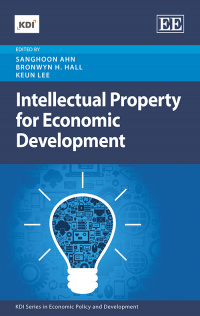Hardback
Intellectual Property for Economic Development
Protection of intellectual property rights (IPRs) serves a dual role in economic development. While it promotes innovation by providing legal protection of inventions, it may retard catch-up and learning by restricting the diffusion of innovations. Does stronger IPR protection in a developing country encourage technology development in or technology transfer to that country? This book aims to address the issue, covering diverse forms of IPRs, diverse actors in innovation, and diverse cases from Asia and Latin America.
More Information
Contributors
Contents
More Information
Protection of intellectual property rights (IPRs) serves a dual role in economic development. While it promotes innovation by providing legal protection of inventions, it may retard catch-up and learning by restricting the diffusion of innovations. Does stronger IPR protection in a developing country encourage technology development in or technology transfer to that country? This book aims to address the issue, covering diverse forms of IPRs, varied actors in innovation, and multiple case studies from Asia and Latin America. IPRs and their interaction with other factors such as such as the quality of knowledge institutions (e.g. academia, public research institutes or industrial research centres such as science parks), availability of trained human capital, and networks for research collaboration or interaction (e.g. university-industry research collaboration or international collaboration) in a development context, is the subject of this book.
Intellectual Property for Economic Development:
• Considers the diverse forms of IPRs and technology transfer and their implications for economic development.
• Analyzes the role of inventors in different contexts including those in universities and in domestic and international mobility and collaborations.
• Presents in-depth analyses of specific issues involving IPRs in the context of countries at different levels of development, including Mexico, China and Korea. Focus is paid to the differences between East Asia and Latin America.
This book will appeal to academics and researchers in the areas of development economics, the economics of IP, law and economics and IP innovation.
Intellectual Property for Economic Development:
• Considers the diverse forms of IPRs and technology transfer and their implications for economic development.
• Analyzes the role of inventors in different contexts including those in universities and in domestic and international mobility and collaborations.
• Presents in-depth analyses of specific issues involving IPRs in the context of countries at different levels of development, including Mexico, China and Korea. Focus is paid to the differences between East Asia and Latin America.
This book will appeal to academics and researchers in the areas of development economics, the economics of IP, law and economics and IP innovation.
Contributors
Contributors: S.A. Ahn, C.R. Durán, B.H. Hall, A. Hu, S. Karmakar, J. Kim, Y.K. Kim, K. Lee, S. Lee, D.C. Lippoldt, G. Marschke, F. Montobbio, S. Nagaoka, T. Naotoshi, K.-H. Park, W.G. Park, V. Sterzi, J. Suh
Contents
Contents
1. Introduction
Sanghoon Ahn, Bronwyn H. Hall and Keun Lee
PART I: DIVERSE FORMS OF INTELLECTUAL PROPERTY RIGHTS
2. Does Patent Protection Help or Hinder Technology Transfer?
Bronwyn H. Hall
3. Channels of Technology Transfer and Intellectual Property Rights in Developing Countries
Walter G. Park and Douglas C. Lippoldt
4. Patents versus Utility Models in a Dynamic Change of an Econmcy: Korea
Keun Lee and Yee Kyoung Kim
5. Protecting Indigenous Knowledge through Geographical Indications: A Case Study of the Textile Industry in India
Suparna Karmakar
PART II. DIVERSE ACTORS IN INNOVATION
6. Impact of University Scientists on Innovations in Nanotechnology
Jinyoung Kim, Sangjoon Lee and Gerald Marschke
7. Assessing the Effects of International Research Collaboration on Invention Process: Some Evidence from Triadic Patent Data
Sadao Nagaoka and Tsukada Naotoshi
8. Empirical Analysis of University Patenting in Korea
Joonghae Suh
PART III: DIVERSE CASES FROM ASIA AND LATIN AMERICA
9. International Patenting and Knowledge Flows in Latin America
Fabio Montobbio and Valerio Sterzi
10. Mexico: Auto Industry and Patenting in a Technological Dependent Economy
Clemente Ruiz Durán
11. Propensity to Patent, Competition and China’s Foreign Patenting Surge
Albert Hu
12. The Determinants of Patenting Activities in the Korean Firms
Kyoo-Ho Park
Index
1. Introduction
Sanghoon Ahn, Bronwyn H. Hall and Keun Lee
PART I: DIVERSE FORMS OF INTELLECTUAL PROPERTY RIGHTS
2. Does Patent Protection Help or Hinder Technology Transfer?
Bronwyn H. Hall
3. Channels of Technology Transfer and Intellectual Property Rights in Developing Countries
Walter G. Park and Douglas C. Lippoldt
4. Patents versus Utility Models in a Dynamic Change of an Econmcy: Korea
Keun Lee and Yee Kyoung Kim
5. Protecting Indigenous Knowledge through Geographical Indications: A Case Study of the Textile Industry in India
Suparna Karmakar
PART II. DIVERSE ACTORS IN INNOVATION
6. Impact of University Scientists on Innovations in Nanotechnology
Jinyoung Kim, Sangjoon Lee and Gerald Marschke
7. Assessing the Effects of International Research Collaboration on Invention Process: Some Evidence from Triadic Patent Data
Sadao Nagaoka and Tsukada Naotoshi
8. Empirical Analysis of University Patenting in Korea
Joonghae Suh
PART III: DIVERSE CASES FROM ASIA AND LATIN AMERICA
9. International Patenting and Knowledge Flows in Latin America
Fabio Montobbio and Valerio Sterzi
10. Mexico: Auto Industry and Patenting in a Technological Dependent Economy
Clemente Ruiz Durán
11. Propensity to Patent, Competition and China’s Foreign Patenting Surge
Albert Hu
12. The Determinants of Patenting Activities in the Korean Firms
Kyoo-Ho Park
Index




